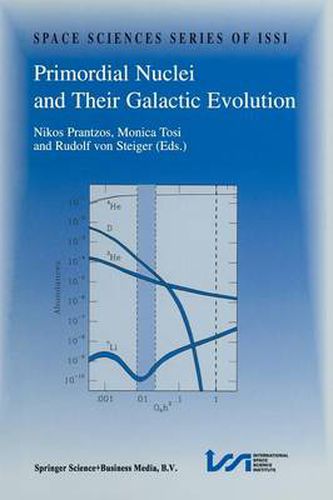Readings Newsletter
Become a Readings Member to make your shopping experience even easier.
Sign in or sign up for free!
You’re not far away from qualifying for FREE standard shipping within Australia
You’ve qualified for FREE standard shipping within Australia
The cart is loading…






This title is printed to order. This book may have been self-published. If so, we cannot guarantee the quality of the content. In the main most books will have gone through the editing process however some may not. We therefore suggest that you be aware of this before ordering this book. If in doubt check either the author or publisher’s details as we are unable to accept any returns unless they are faulty. Please contact us if you have any questions.
The present volume, the fourth one in the Space Sciences Series of ISSI (Inter national Space Science Institute), contains the proceedings of a workshop on Pri mordial Nuclei and Their Galactic Evolution , which was held at ISSI in Bern on 6-10 May 1997. This topic was chosen following some general enquiries with the scientific community concerning its desirability and timeliness. Five convenors, D. Duncan, C. Hogan, J. Linsky, N. Prantzos, and H. Reeves (chair) subsequently set up the workshop, nominated a list of invitees, structured the workshop into a series of introductory talks and into six topical working groups (early Universe extragalactic objects -low-Z stars - galactic disk and galactic evolution - solar nebula -local interstellar medium), and described the tasks of the working groups in a list of keywords. It is the main task of ISSI to bring together space scientists, ground-based observers, and theorists from different fields and to give them the opportunity to discuss and compare their results, thus contributing to the achievement of a deeper understanding, adding value to those results through multi-disciplinary research in an atmosphere of international co-operation. In that spirit the convenors selected participants working in fields ranging from Big Bang theory to observers oftoday’s Solar System, thus spanning the widest possible range both in time and space.
$9.00 standard shipping within Australia
FREE standard shipping within Australia for orders over $100.00
Express & International shipping calculated at checkout
Stock availability can be subject to change without notice. We recommend calling the shop or contacting our online team to check availability of low stock items. Please see our Shopping Online page for more details.
This title is printed to order. This book may have been self-published. If so, we cannot guarantee the quality of the content. In the main most books will have gone through the editing process however some may not. We therefore suggest that you be aware of this before ordering this book. If in doubt check either the author or publisher’s details as we are unable to accept any returns unless they are faulty. Please contact us if you have any questions.
The present volume, the fourth one in the Space Sciences Series of ISSI (Inter national Space Science Institute), contains the proceedings of a workshop on Pri mordial Nuclei and Their Galactic Evolution , which was held at ISSI in Bern on 6-10 May 1997. This topic was chosen following some general enquiries with the scientific community concerning its desirability and timeliness. Five convenors, D. Duncan, C. Hogan, J. Linsky, N. Prantzos, and H. Reeves (chair) subsequently set up the workshop, nominated a list of invitees, structured the workshop into a series of introductory talks and into six topical working groups (early Universe extragalactic objects -low-Z stars - galactic disk and galactic evolution - solar nebula -local interstellar medium), and described the tasks of the working groups in a list of keywords. It is the main task of ISSI to bring together space scientists, ground-based observers, and theorists from different fields and to give them the opportunity to discuss and compare their results, thus contributing to the achievement of a deeper understanding, adding value to those results through multi-disciplinary research in an atmosphere of international co-operation. In that spirit the convenors selected participants working in fields ranging from Big Bang theory to observers oftoday’s Solar System, thus spanning the widest possible range both in time and space.